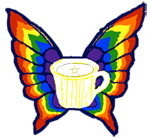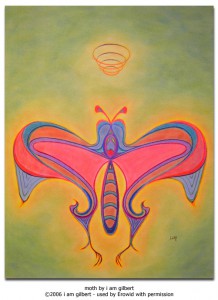Tastes Like Candyflipping
If I had a dollar for every time I’ve heard someone describe the latest supposedly-not-even-illegal-yet white powder as being “like a cross between acid and ecstasy”, I could buy me a sheet of actual acid and a couple grams of genuine MDMA. And then the Teafærie would be a very happy girl.
A silly friend of mine recently had a rather horrible trip on something that was sold simply as “NBOMe” (which is already confusing, since this designation includes a series of substances). In any event, whatever it was that she took had been described at point-of-sale as feeling like “taking acid and ecstasy at the same time, only sexier”, a description that is arguably not without merit. But it is also woefully incomplete. In particular, it would have been helpful if the young entrepreneur had bothered to give my friend more appropriate dosage information. Perhaps then my friend might not have gotten caught up in an endless series of nested and interlocking personal hell loops. These could probably have been avoided if she’d bothered to look it up on Erowid. But she was at some freaking desert party out in the boonies where there was a distinct lack of Internet. So she decided to try a new substance (in public!) without doing her homework first, and became something of a vivid object lesson to the folks around her: “Don’t let this happen to you!”
It’s a well-worn truism that it’s impossible to satisfactorily describe what tripping is really like to a person who has never taken a psychedelic drug. Endeavoring to do so has been compared to trying to tell a blind person about the nature of color, or attempting to describe a symphony to someone who was born deaf.
In contrast, describing the idiosyncratic effects of a novel drug to an experienced psychonaut feels to me more like trying to characterize a musical genre to a hearing person who hasn’t encountered that particular groove before. It’s an easier task if the listener already has a passing familiarity with a related genre. For example, it would be relatively simple for me to describe hip-hop to somebody who had grown up listening to old school rap music. So, in some ways, it makes sense to describe a drug’s action by comparing it to the effects of relatively similar substances. And acid and ecstasy are both common enough that they naturally come up as standard reference points. But when it comes down to it, nothing besides a real live (well, hopefully dead) chicken actually tastes exactly like chicken. If I wanted to describe how an alligator tastes, I would probably communicate more effectively to my listeners if I tried my best to tell them the ways that it differs from chicken.
Comparisons can still be wildly misleading, especially if the person who is doing the talking doesn’t have enough firsthand experience with the substances in question to effectively differentiate between them. The first time I tried 5-MeO-DMT, for instance, my well-meaning provider told me that it was “just like DMT, only different”. Nothing could have been further from the truth, of course. They are unique substances, and their subjective effects couldn’t be more dissimilar. But this person had apparently been present when others had done them, and in retrospect, I can see how they could seem roughly analogous to an outside observer. Which is to say, in both cases the tremulous psychonaut vaporizes a few hits of some strange substance and then proceeds to pass out for several minutes, after which he or she tends to return to normal consciousness somewhat overawed and unable to adequately describe whatever it was that just happened.
Even firsthand descriptions of a drug’s effects are bound to be approximations; many types of experiences are maddeningly difficult to put across to anybody who hasn’t actually been there themself. Imagine, for instance, that the Teafærie managed to kidnap a young Amish girl who had never been exposed to any sort of electronica at all and forced her to listen to dubstep. Once I returned her to her friends and family, she might attempt to describe what she had heard. Perhaps she would say that it sounded like what gigantic pieces of forbidden farm machinery would sound like if the devil had brought them to life and caused them all to experience severe gastric distress whilst simultaneously attempting to copulate with and destroy one another.
Now, that might sound like a humorously accurate description of dubstep to a person who happens to know (and loathe) it. But nobody’s going to be able to mentally construct anything that sounds even roughly like actual dubstep from such a description. Nor can someone who has never personally taken DMT come any closer to correctly imagining the phenomenon that Terence McKenna famously described as elf-machines from hyperspace busily using a visible language to manifest intricate objects.
I’m endlessly fascinated with people’s attempts to describe this stuff, though, because it’s a fun challenge and an extremely important endeavor. We are currently in the process of evolving and finessing a language for talking about subjective states of consciousness, a process that has been both advanced and necessitated by the semi-sudden appearance and widening availability of a whole new slew of designer drugs.
In order to do a better job of communicating about psychoactives we’re going to have to continue to expand our language. This starts with familiarizing ourselves with the emerging vocabulary used to describe psychedelic states, and actively contributing to the evolving conversation about the ways that these new terms should be used. There is a great deal of both philosophical and linguistic dissent regarding these matters. What does it indicate when we say that a substance is psychedelic, for instance? Is “entheogen” just a loftier-sounding word for the same thing, or does it tend to suggest a particular quality? What is implied by the term “plant teacher”? What’s the difference between an empathogen and an entactogen? What do we mean when we say that something is addictive, and how does that differ from suggesting that it may be habit-forming?
Then, there are all of the less categorical and more colorfully descriptive words, such as speedy, rushy, heavy, heady, sparkly, strobey, and dark. (I’m seeing a parody of Snow White here somewhere…)
Ultimately, it’s impossible to know what a new experience is really going to be like until you’ve tried it for yourself. This is true of everything from riding a roller-coaster to falling in love. For one thing, every individual is different. My personal reaction to any particular chemical is naturally going to be at least a little different from everybody else’s, because I have my own unique chemistry—to say nothing of set, setting, and dosage. So maybe the best way to try to find out about a drug’s action in advance is to collect a whole bunch of varying descriptions of its effects, and then check to see what (if anything) they all have in common, while at the same time taking note of any recurring anomalies.
It would be instructive if somebody designed a massive anonymous web survey that first queries participants on which substances they have tried and at what dosage levels. Then they would be asked to rate the specified drugs on a scale of 1-10 for each of a wide-ranging list of adjectives and short descriptors such as: psychedelic, empathogenic, erotogenic, euphoric, dysphoric, dissociative, visual, immersive, inhabited, intense, insightful, spiritual, speedy, life-changing, dance-enhancing, difficult to control, difficult to remember, deliriant, dissociative, physically discomfiting, anxiolytic, psycholytic, creativity-enhancing or time-distorting. The collective results could then be mapped out with pretty infographics.
What would really be awesome, though, would be if somebody collected all of the data that they could find about almost every single popular substance, and then put the most relevant information on the web for easy access. There could be notes about each drug’s history, chemistry, dosage, and legal status, as well as generalized summaries of its effects. Plus, they could include detailed trip reports so that potential users (as well as the merely curious, the academic researchers, and anyone else with an interest) could peruse the personal experiences of those who have gone before.
Oh, wait… it’s already being done. I love living in the future! •
Originally published in Erowid Extracts 25, December 2013.



